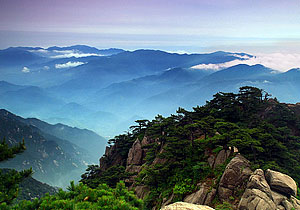Huangshan (Yellow Mountain)

Yellow Mountain (Mt. Huangshan) can be found in the south of Anhui province, covering a total area of 1200 square kilometers, with the best tourist sights lying across an area of 154 square kilometers. Yellow Mountain was named a World Natural and Cultural Heritage Site by UNCSCO in 1990 for its brilliant natural beauty, great variety in zoological species, and historic relics of Huizhou culture (a civilization that originated in southern Anhui) and religion culture.
The Yellow Mountain got its name in 747 AD after the legendary Yellow Emperor, a mythical ancestor of the Chinese who is believed to live and refine elixir and become an immortal in this mountain.
Yellow Mountain is a perfect destination for exploring marvelous natural beauty and researching geological transition. Through centuries of crust movement the Yellow Mountain has formed into many sheer granite peaks and cliffs. The five classic natural wonders of Yellow Mountain, namely quaint pines, grotesque stones, sea of clouds, hot springs, and winter snowscape will bring a feast of your eyes. Moreover, watching the sunrise atop the peaks of Yellow Mountain is another highly recommended activity.
Throughout the centuries, Yellow Mountain bears fame in great numbers of books, poems and paintings as well as carved inscriptions. Poetic phrases in handsome calligraphy can be found in many spots on the mountain. Yellow Mountain is also a renowned holy mountain of Taoism. Scenic spots that are relevant to Taoism include Xianren Peak, Liandan Pavilion, Shenxian Cave, and so on. Ancient bridges, towers, temples scattered across the mountains constitute a natural historical museum of the splendid local culture.
Hiking up the mountains is a popular activity among tourists. But there are also 3 telpher routes offered to save your time and effort from the middle part of the climb to the summits. It will be another kind of fun.